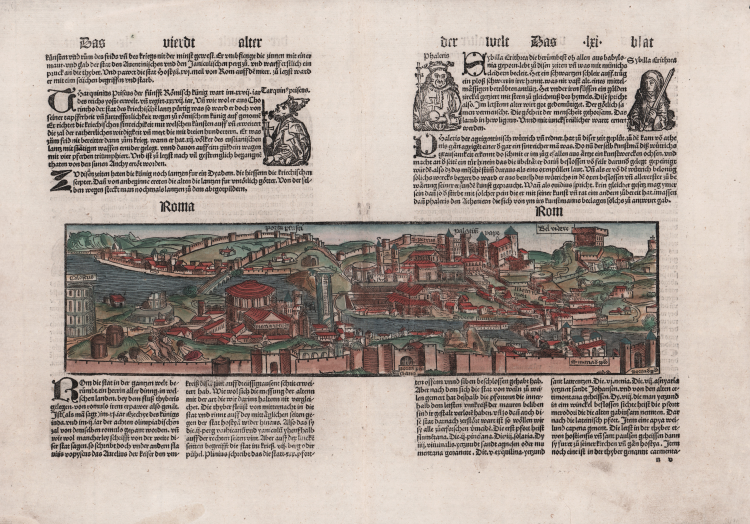



| Reference: | s29425 |
| Author | Johann Schönsperger |
| Year: | 1496 |
| Zone: | Rome |
| Printed: | Basle |
| Measures: | 350 x 100 mm |


| Reference: | s29425 |
| Author | Johann Schönsperger |
| Year: | 1496 |
| Zone: | Rome |
| Printed: | Basle |
| Measures: | 350 x 100 mm |
Fantastic view of the city placed in the lower part of the sheet that also contains the descriptive text, taken from the "Liber cronicarum cum figuris et umaginibus ab initio mudi usus mit temporis", the very rare "pocket edition" of the famous chronicle of the world, published in Ausburg by Johann Schonsperger, in 1496.
First German edition of the Schonsperger. He shortened both the text and the format of the Schedel to produce an edition that was more manageable and marketable than that of A. Koberger.
"In 1469 an edition of the Chronicle of Nuremberg was produced in reduced format by J. Schonsperger in which the images are reduced copies of the original ones and also the texts are synthesized. This edition (the second one in German) is however much rarer than the first one. The publisher Schonsperger is known because he used in Nuremberg a new gothic character called Fraktur in the poem composed for the death of Maximilian I" (see Marigliani p. 117).
Woodcut, with fine later hand colour, excellent condition. Very rare.
Bibliografia
C. Marigliani, "Le Piante di Roma delle collezioni private", n. 10.
Johann Schönsperger (1455-1521 circa)
|
Schönsperger set up a print shop in 1481 together with the goldsmith Thomas Rüger († 1483) and worked closely with his stepfather Johann Bämler († 1503)[1]. Together with other Augsburg printers, the company was able to dominate the book market for German literature in Augsburg between 1480 and 1500. Schönsperger went partially bankrupt in 1507 and never recovered financially. In 1508, probably through the mediation of Konrad Peutinger, he became the secret printer to Emperor Maximilian I. He printed the “Theuerdank” and the prayer book for the Order of St. George for the emperor. The types designed for these two projects are milestones in the development of Fraktur. His Bibles (Schönsperger Bibles) of 1487 and 1490 also became famous (see the article Pre-Lutheran German Bibles). In 1497, Schönsperger's print shop in Augsburg published the so-called “Kleine Schedel”, an abridged edition of Schedel's World Chronicle. As this pirated edition was printed on poorer quality paper, the Augsburg edition is even rarer today than the Nuremberg original.
|
Johann Schönsperger (1455-1521 circa)
|
Schönsperger set up a print shop in 1481 together with the goldsmith Thomas Rüger († 1483) and worked closely with his stepfather Johann Bämler († 1503)[1]. Together with other Augsburg printers, the company was able to dominate the book market for German literature in Augsburg between 1480 and 1500. Schönsperger went partially bankrupt in 1507 and never recovered financially. In 1508, probably through the mediation of Konrad Peutinger, he became the secret printer to Emperor Maximilian I. He printed the “Theuerdank” and the prayer book for the Order of St. George for the emperor. The types designed for these two projects are milestones in the development of Fraktur. His Bibles (Schönsperger Bibles) of 1487 and 1490 also became famous (see the article Pre-Lutheran German Bibles). In 1497, Schönsperger's print shop in Augsburg published the so-called “Kleine Schedel”, an abridged edition of Schedel's World Chronicle. As this pirated edition was printed on poorer quality paper, the Augsburg edition is even rarer today than the Nuremberg original.
|